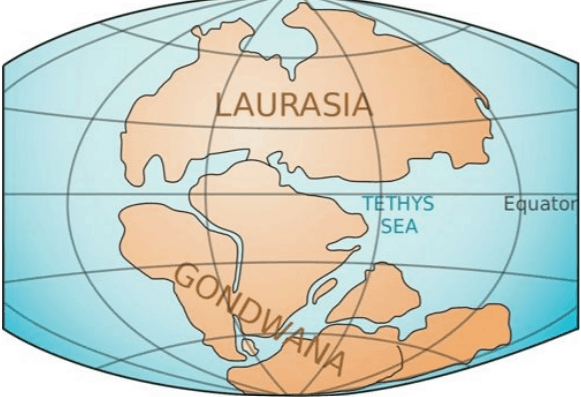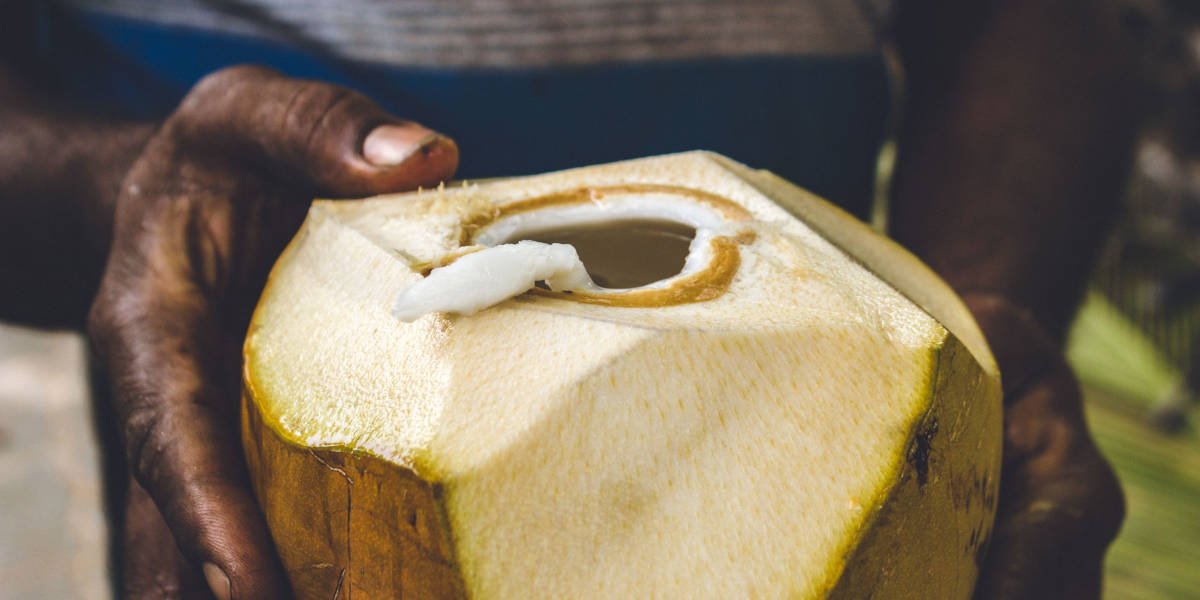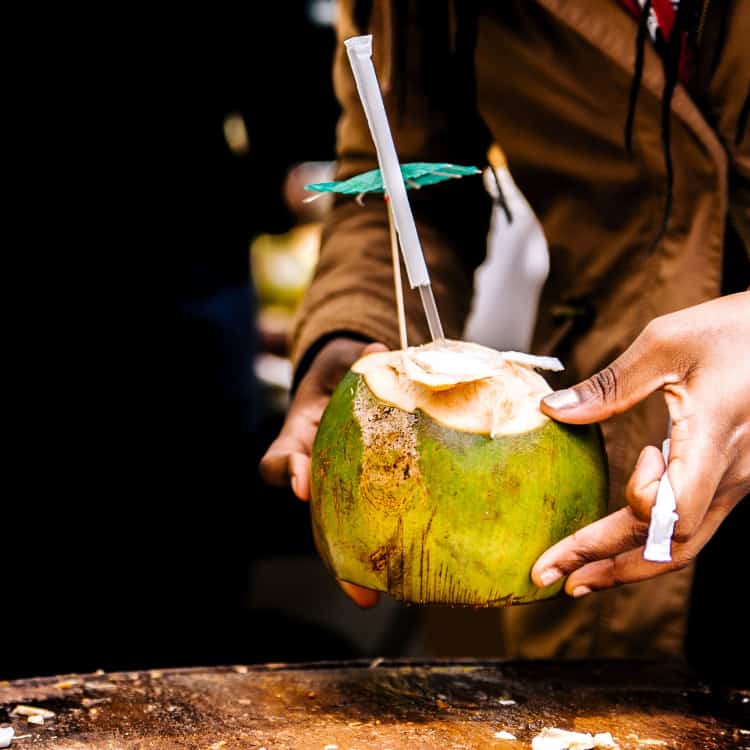Coconuts may be one of the most fascinating and diversely useful plants in the world. They are also one of the oldest. The fossil record of coconuts goes back literally tens of millions of years. Today, let’s learn about the history of coconut.
Widely identified as a type of palm tree, the coconut, like all palms, is not really a tree at all. The fronds of the coconut are actually leaves. What we think of as the trunk is actually its single stem.
Botanically, the coconut is a woody perennial monocotyledon. It has no bark and no true branches.
The history of coconut
It might seem that such an ancient plant would be relegated to the annals of history and no longer useful in the modern world, but in the case of the coconut, just the opposite is true.
Coconuts most likely evolved on the shores of lagoons surrounding coral reef islands. Their adaptation to the shoreline provided access to the fresh water lens just beneath the surface of the rocky beach, above the high tide line. Here their roots could tap the fresh water which pools above the salt water table beneath the sands.
Whether they evolved during the break-up of the great super-continents or just after is unknown. But the natural territorial range of the coconut, as well as its coastal habit, suggest it could well have evolved during the Cretaceous period as India was separating from the main landmass of Gondwana. The oldest wild cocos forms could well have evolved along the coastal waters of the Tethys Sea as the once solid landmass of Pangaea began to break up, creating inland waterways around the Tethys Sea between what would become India, Madagascar, Australia, Antarctica and Eastern Africa.
We may never know the true place of origin of the coconut, with its most closely related ‘cousins’ in South America and its widest variety of forms in the Asiatic Pacific Ocean; it still has no truly Asian form.
What we do know with some degree of certainty is that the coral reef atoll is the oldest and most stable ecosystem on earth, and the coconut palm is its most successful plant form.

and Ceylon, Indonesia, the Philippines and along the equatorial waters of the Pacific and Indian Oceans.
This map demonstrates the proximity of these countries in earlier times. (Source: “Laurasia-Gondwana”)
A Coast Dweller and Ancient Mariner
The coconut has evolved to tolerate both the salt and high humidity levels of open ocean coastlines and to withstand the prevalent high winds which these locations often experience.
As Darwin discovered in his experiments with coconuts in the mid-19th century, mature coconut fruits have the ability to withstand the effects of salt water for long periods. While the outer skin of the husk is slightly permeable, the coconut is able to survive direct exposure to the ocean for months at a time without losing the viability of the seed stored safely within.
The ability of coconut seeds to remain viable for many months has also contributed to its spread across the world, both locally, by free floating coconuts on open ocean currents, and on much longer journeys carried by mariners who brought quantities of the mature fruits for planting in their new settlements and for sustenance during long ocean going voyages. Recent research into the DNA of coconuts has provided a fascinating map of the world based on these ancient trade routes as they carried two distinct lines of coconut in opposing directions around the globe.
Another big question about coconut origins and distribution is whether that distribution occurred mostly through the natural dispersal of coconuts floating on open ocean currents or predominantly by the transport of coconuts by humans on sailing craft along ancient trade routes. It is clear that both methods did, and still do occur. What is less clear is what percentage of distribution has been caused by either method and to which locations. The one fairly certain fact is that all coconuts of the Atlantic Ocean were transported by humans and not by open ocean dispersal of nuts. This is because there were no connecting waterways between the ancient coconut growing regions of the world and the Atlantic Ocean.

Continental Shifts and Changing Oceans
The movement of the tectonic plates and landmasses during the ancient periods which span millions of years make it difficult to precisely pin point where and when coconuts evolved. But it is clear that both the habit of coconuts to float in the waters where they fall from the graceful arching palms and their delayed germination make it possible for the fruits to travel, both short and fairly long distances by water to new germination sites.
The formation of the modern oceans and the movement of the continents as they formed provided no access to the Atlantic Ocean from the areas of the coastal waterways where wild coconuts are known to have established and flourished. Historical evidence suggests there are no native Atlantic Ocean coconuts. Those instances where coconuts have been claimed to have been discovered on Atlantic coastlines or islands have either been recognized as not being coconut palms (as in the case of Columbus, who found native Royal Palms in the Caribbean, and called them coconuts) or to have been planted earlier by visiting missionaries or explorers.

There is some dispute as to when coconuts were first planted on the Atlantic coast of the new world, with some sources claiming that the first coconuts were planted in the 1490’s on Caribbean islands. A direct historical record places a former Cape Verde Island pastor, Diego Corenco, in Puerto Rico in 1549 and introducing the first coconuts of the Caribbean at that time.
Coconuts on the Pacific coast of South America appear to be directly related to known coconut types of the Asiatic Pacific regions, and there is still some question as to the true origins of these plants. Some believe them to be native to South America and others believe they either migrated on ancient ocean currents from the Asiatic Pacific or were brought to South America by early Spanish explorers.
In cultures where coconuts were a natural part of the landscape, they were used in almost every conceivable aspect of daily life and were a major dietary staple, source of building materials, rope, food, drink and medicine. In areas where coconuts were introduced, native peoples have no such relationship with them. The Indians of the Amazon are an example of this phenomenon.
Studies conducted in Hawaii and the Solomon Islands have documented that coconut seeds can remain viable for up to four months while floating at sea. This long dormancy prior to germination provides substantiating evidence for Beccari’s theory that the palms of the Palmyra Atoll were the result of natural evolution.
The Palmyra Atoll is of particular interest in this regard because it is so isolated. Located thousands of miles northeast of the atolls of the South Pacific and some thousand miles south of Hawaii, it is also quite small and with only slight elevation above sea level over most of the land mass of its four islands, making it ideal habitat for coconuts to wash ashore, germinate and develop into fully mature coconut palms. Beccari writes:
The Palmyra Islands belong to the category of those uninhabited coral islands, covered with dense groves of coconut palms and of which Simmonds writes, as reported by O.F. Cook, “the ungathered nuts which have fallen year after year, lie upon the ground in incredible quantities.
The special circumstances in which the Palmyra Islands are placed; their coral origin; their isolation, consequent to the great distance from any other land; the complete absence of indigenous inhabitants; the want of drinking water; the absence of any traces of economic plants that might suggest that they had ever been inhabited; and the certainty that they are but seldom visited either by fishermen or by any person who has tried to turn their wealth (which consists of the coconut solely) into a source of profit – all this give me the occasion, in addition to describing the peculiar characteristics of the coconut produced in these islands, to offer certain considerations of an evolutionary and geographic nature, opposed to those which Mr. O. F. Cook has advanced with much competence and erudition in his two memoirs on the coconut palm.
Delayed germination is believed to have allowed the most ancient forms of the coconut to begin their great oceanic journeys during the breakup of the great southern supercontinent Gondwana, some 30 to 60 million years ago.
Various researchers have concluded that coconuts evolved in the MalayIndonesia area, dispersing on the seas along island coastlines in the Pacific and Indian oceans. Coconuts fossils found in Queensland, Australia in the 1990’s place coconut palms in the region two million years ago.
Research since the 1990’s has revealed ancient coconut pollen on the Cook Islands dating back many millennia before the first known human inhabitants, and these discoveries in combination with the 2 million year old coconut fossil of Australia make it clear that in this area of the world, at least, coconuts far predate humans.
Coconuts and Ancient Peoples
The legends of the coconut are many, and the records of coconuts in their native lands date back many thousands of years. Coconuts have long been integral to the human diet in the regions where they grow, providing nutrient dense food and drink, cooking oil, vinegar, sugar, syrup and even an alcoholic beverage. The husk and shell provided material for everything from rope to upholstery material for mattresses and furniture, household dishes and utensils and decorative veneers, buttons, and accessories. The trunks and fronds provided building and roofing materials. Coconut oil has also been used medicinally, as has the bark and root of the coconut. The oil was used extensively for cooking, lighting, and later for fuel, as well as soap making and for skin and body care lotions and creams. Its great usefulness made it an important and prized plant in all ancient cultures where it grew and also made it an important plant to carry with the people during times of expansion, migration and ocean voyaging.

Migrations and expansions of peoples throughout the South-Western Pacific Rim and across the islands eastward further spread the coconut. It is now known that in the native coconut regions of the South Pacific, people were voyaging across the islands some 3,000 years ago. Austronesian peoples, having traveled into Southeast Asia in the century before, now spread out across the Pacific atolls. Fossilized remains of coconuts found in association with settlements which contained Lapita pottery in the islands of Papua New Guinea have been dated at 3,500 years old.
There are several sources which claim that the first known written mention of the coconut occurs in the Sallier papyrus dated 1650 BC. Purportedly, the papyrus states that a specimen of the plant is contained in the botanical collection of Tethmosis, or Tothmes I, the third king of Egypt’s 18 th dynasty. The coconut played an important role in the culture of ancient India and Sri Lanka (Ceylon).
The original Sushruta Ayurveda (1400-1000 BC), includes a reference to coconut as a medicinal plant. The coconut is also deeply encoded in the rituals of Hinduism. In what is believed to be the same time frame, the first Polynesians were navigating the Pacific Ocean in explorations which would eventually reach Hawaii. Included in the provisions they carried were taro, chickens, pigs, shampoo ginger, sugar cane, bananas and coconuts.
The coconut was also included in the “Mahavanso”, an epic poetic chronicle written in the Pali language describing the reign of the kings of ancient Sri Lanka (Ceylon) beginning in about 550 BC. The text notes that coconut palms were well known on the island in 161 BC. The Greek physician Ctesias is also said to have written about coconuts, most likely as a part of his “History of Indica [India]” which he wrote based on accounts by Persian visitors and visits by Indian merchants and envoys to the Persian court during his time there. The work remained as the only writing about India until the time of Alexander the Great, however, only an abstract of his writing, compiled in the 6 th century AD survives to the modern age.
There is some indication that coconut oil and shells were carried across the overland route to Europe by Arab traders as early as the 1 st century AD, and that these items eventually reached as far north as England. There was, however, apparently no trade in either the whole coconuts or the dried meat. This trade in the shells, at least, is fairly well substantiated, although somewhat later in the historical record, by the presence throughout Europe from Spain to Scotland of various antique coconut shell cups. Cups were either made of coconut shell with ornate ‘feet’, inner linings or decorations of various metals or were made of precious metals in the shape of coconuts. The cups were found in cathedrals and castles.
Often used as religious items, the coconut cups were among the possessions of popes, cardinals, archbishops and bishops dating back to at least 1200 AD. One example of such a cup was named in the final bequest of a Bishop of Durham in 1259 as “for my niece Isabella, a cup of nut Indy”.

Over the next six centuries coconut cups would become common among Royalty and noblemen throughout Europe and many can be found today in auctions and antique dealers. In an extraordinary auction at Christies of London in 2002, titled ‘Mutiny on the Bounty’ a coconut cup once belonging to William Bligh was auctioned. The infamous Lieutenant William Bligh, on an earlier unsuccessful voyage to collect breadfruit from Tahiti, during which they had purchased coconuts for the journey, inscribed a coconut cup with the words ‘The Cup I eat my miserable allowance of’. This cup was sold at auction at Christies of London on September 26, 2002 for one hundred eleven thousand eight hundred and fifty two dollars US ($111,852).
In a richly detailed account of his travels, the journals of Ibn Battuta of Tangier from 1325 to 1354 throughout Asia and Africa recount the prolific cultivation and use of coconuts. In his description of Dhofar in the south of Oman, he includes the following passage:
The many uses of the coconut
One of its peculiarities is that oil, milk and honey are extracted from it. The honey is made in this fashion. They cut a stalk on which the fruit grows, leaving two fingers’ length, and on this they tie a small bowl, into which the sap drips. If this has been done in the morning, a servant climbs up again in the evening with two bowls, one filled with water.
He pours into the other the sap that has collected, then washes the stalk, cuts off a small piece, and ties on another bowl. The same thing is repeated next morning until a good deal of the sap has been collected, when it is cooked until it thickens. It then makes an excellent honey, and the merchants of India, Yemen, and China buy it and take it to their own countries, where they manufacture sweetmeats from it. The milk is made by steeping the contents of the nut in water, which takes on the colour and taste of milk and is used along with food. To make the oil, the ripe nuts are peeled and the contents dried in the sun, then cooked in cauldrons and the oil extracted. They use it for lighting and dip bread in it, and the women put it on their hair.
Originally posted 2020-05-19 15:57:29.

